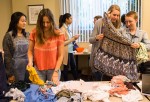”The more I cared about performing well, the more I would become frustrated with my inability to silence the noisy critic living inside my head.”
PRIME: Slowing the Storm
There are places and people who change us immeasurably, quietly, without us noticing, until we look up one rainy day and realize that they were the compass that guided us. These are the memories I want with me when I leave.
Men’s water polo heads to NCAA semifinals with 18-6 bombardment of George Washington
The Bruins took “team water polo” to a new level Thursday night.
Eleven players scored in No. 3 seed UCLA men’s water polo’s 18-6 win over No. 6 seed George Washington (23-7) in the final opening round of the NCAA championship.
The Bruins jumped out to a four-goal lead within the first half of the opening frame. Five Bruins scored in the quarter as UCLA took a 5-2 lead going into the second quarter.
UCLA’s first eight goals were scored by eight different players before freshman attacker Ashworth Molthen netted his second of the game with 20 seconds left in the half.
The Bruins held the Colonials to just one goal in the frame, leading 9-3 at the half.
UCLA continued to pull away in the third period. Senior attacker Austin Rone scored twice and Molthen completed a hat trick. The Bruins carried a 15-3 advantage into the final quarter.
The Bruins’ defense let up in the fourth frame, as the Colonials scored three times in the first half of the quarter. Sophomore attacker Nicolas Saveljic completed his hat trick in the quarter as the Bruins closed out the victory.
UCLA will face No. 2 seed USC (28-3) in the second semifinal Saturday night. The teams are 1-1 against each other this year, both games having been played at USC’s Uytengsu Aquatics Center.
The Quad: Students cultivate re-commerce industry to counter fast fashion’s ecological harm
The word “pollution” tends to evoke images of devastating oil spills in vast oceans or black fumes spilling from big, industrial factories.
Interestingly, the tremendous environmental implications behind the trendy clothes that hang in our own closets seem to constantly slip our minds.
With the recent completion of discount shopping blowouts like Black Friday and Cyber Monday, flashy price deals and new fashion trends continue to dominate the consumer market. And amid these ever-changing fashion vogues, the general public tends to overlook the driving force behind the booming fashion industry – its multiplicity and ability to quickly and easily mass distribute. This is fast fashion.
According to the Independent, fast fashion is an innovative means of fashion production that concentrates on cutting the time and cost it takes to produce frequent new collections inspired by catwalk looks or celebrity styles, often at the expense of environmental preservation and safety. Familiar brands such as H&M, Zara and Forever 21 often use this method of production.
Producers of fast fashion use pesticides and fertilizers, as well as emit high levels of carbon dioxide, ultimately leading to heightened pollution levels of our air, farmland and water.
According to the World Resources Institute, cotton, the most common natural fiber used to make clothing, accounts for about 33 percent of all textile fibers. Cotton clothing production does not only contribute to scarcity in areas facing water stress, but also accounts for 24 percent of insecticides and 11 percent of pesticides, even though it uses just 3 percent of the world’s arable land.
From start to finish, the process of clothing production places an extreme burden on the natural environment. The process starts with intense raw material extraction for cotton textiles, proceeds to contaminate drinking water and soil through factory production and ends with the discard of major textile waste that ultimately pollutes and contributes to climate change.
When we look at the life span of products, styles are much more short-lived today. People wear items for a shorter period of time, and the end of the life cycle of these pieces often means overstock and unused items are burned, releasing toxic chemicals into the atmosphere.
Consumers can work to combat this cycle, however.
Isabel Schulte, a second-year chemical engineering student and president of Unravel at UCLA, an organization that responds to this environmental harm primarily through education, said clothes have the biggest negative impact during their use cycle, which is where consumer choices can make the biggest difference.
“Making a small change has large implications in that thrifting reduces textile waste by reselling clothing, and therefore lowers the need for new clothing production,” Schulte said.
With the emergence of secondhand clothing stores and thrift shops, buying pre-owned fashion has slowly been introducing itself as an economical and enjoyable way to add personal taste to your wardrobe, all while taking care of the environment.
Hannah Sullivan, a second-year global studies and communication student founded TAKE OUT Clothing, which responds to the pressing environmental implications of the fashion industry by using mostly thrifted fabric and materials to create new looks, while using as little new material as possible. Additionally, TAKE OUT items are produced by hand rather than in a large, polluting factory.
“When you choose to shop at thrift stores, you are contributing to the recycling of clothing items that are already in existence,” Sullivan said. “Instead of allowing clothing to be thrown to landfills or burned into the atmosphere, you are giving new life to an old item.”
Thrifting has undoubtedly grown more mainstream. This rise into the limelight has even stimulated the “re-commerce” industry, as evident in the booming popularity of clothing resale websites and apps such as Depop and Poshmark.
Despite this wave of popularity, in an economy where price is equated with value a cheap product is usually associated with being lower-quality or is tagged as a “charity case.”
Schulte said she sees stigma associated with thrifting, but believes it is primarily tied to a choice. While thrifting by choice can be trendy and fashionable, Schulte said the stigma arises when someone is thrifting out of necessity because buying fast fashion is out of their financial means.
“Unfortunately, thrifting is inherently tied to class stigma and discrimination, so the stigma attached to secondhand shopping cannot be fully addressed until the larger class stigma is broken,” Schulte said.
Ultimately, as styles are quickly changing and demand is rising, fast fashion and ethical fashion have become increasingly antithetical. On one hand, fast fashion is an economic bonanza that helps meet these demands, but on the other hand, its production is unethical and unsustainable. We may not have a solution now, but it is only a matter of time until garment needs meet our world’s natural confines.
“It is critical that we familiarize ourselves with the importance of ethical fashion in an industry that is likely to only grow,” Sullivan said. “Part of this understanding is knowing how secondhand shopping contributes to this movement.”
Gallery: UCLA men’s basketball defeats Hawai’i 80-61
The Bruins broke their two-game losing streak against the Rainbow Warriors on Wednesday night.
Rain causes flooding in Murphy Hall, disrupts services temporarily
Students and administration officials found Murphy Hall flooded Thursday morning due to heavy rainfall.
The flood at Murphy Hall started around 8 a.m., according to UCLA Facilities Management.
Some campus services experienced interruptions due to the flooding. The financial aid office temporarily relocated across the hall as plumbers worked to handle the flood. The registrar’s office also experienced a closure, but was fully open by 10 a.m.
Nurit Katz, executive officer of Facilities Management, said that clogged roof drains caused the air conditioning pipes to malfunction and flood the offices.
The Fernald Child Study Center and the Center for the Health Sciences also experienced flooding, Katz said.
Daniel Wefers, a fourth-year mechanical engineering student, was scheduled to meet with a financial aid advisor at 9:30 a.m., but found out about the flood just minutes before the appointment.
“Since it’s not an urgent appointment, I’ll probably come back … on Monday and ask when they plan to have me,” Wefers said.
Financial aid services have temporarily been moved to A128 Murphy Hall while plumbers clear the flood.
’10 Questions’ inquires into individual and group knowledge in art and science
The “10 Questions” lecture series, which will address a different question each week, doubles as a course for students and a panel open to the public. The series will explore open-ended questions such as “What is beauty?”, “What is failure?” and “What is knowledge?”
Each week’s panel will feature two faculty members from the School of the Arts and Architecture and two faculty members from other departments who will approach the question of the week from the perspective of their academic disciplines.
A UCLA professor recited René Descartes’ famous quote, “I think, therefore I am,” to illustrate the popular notion that the mind and body are distinct, separate entities.
Victoria Marks, a dance professor, was one of the four speakers at the “10 Questions” panel Tuesday that explored the question “What is knowledge?”
Marks said she disagreed with Descartes, because she believes the mind and body generate knowledge as one entity rather than as two separate sources.
“Everything we know comes from our experience,” she said. “We’re in a continuous sensory conversation with what’s going on outside of us and inside of us.”
Todd Presner, a Germanic languages and comparative literature professor and chair of UCLA’s digital humanities program, said he thinks knowledge is inextricable from power.
Presner said human knowledge is not a coincidence but, rather, a byproduct of the power structures that influence whether and how knowledge is passed on.
He said that much of the historical knowledge we possess, which comes in the form of records, testimonies and legal documents, was generated by the upper class of that given era, and thus intrinsically comprises a one-sided account of what happened. The experiences of the lower class are often forgotten.
Marcelo Suárez-Orozco, distinguished professor of education and psychological anthropologist, said knowledge is crucial for society to function as we know it.
“Knowledge is a fundamental pillar of civilization,” he said.
He said democracy is dependent on knowledge and cited graphic representations of human mass migration to highlight the interdependence of the various ways of knowing. The graphs were artistic, but also incorporated quantitative data, supporting Suárez-Orozco’s thought that it’s fundamentally impossible to separate scientific ways of knowing from artistic ways of knowing.
Kristy Edmunds, an artist, curator and the executive and artistic director of the UCLA Center for the Art of Performance, said she believes knowledge is a gift, passed on from person to person. She spoke about the Native American peace pipe – a ceremonial object – to illustrate her point.
“The peace pipe is brought out at the most significant moments of a tribe,” she said. “The knowledge shared in the presence of a peace pipe must be passed on and saved.”
To close the lecture, the four speakers discussed one another’s presentations and conducted a question-and-answer session with the audience members.
During the panelists’ conversation, Suárez-Orozco said Presner’s lecture on the existence of buried knowledge is an opportunity to mend historical hurt.
“Acknowledgment, and the politics of acknowledgment, becomes essential to the healing of extraordinary damage that humans can do to one another,” Suárez-Orozco said.
Petra Silvey-Karvounis, a second-year sociology student who attended the lecture, said that, before the lecture, she thought of knowledge as something a person knows, learns or does.
“But now, I think of knowledge as a collective understanding that unfolds slowly throughout one’s life,” Silvey-Karvounis said. “It’s more like an energy that flows through, takes different forms and can be visceral. It’s very nuanced.”






